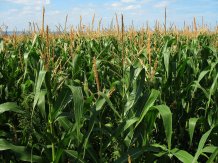Articles

The research provides a clearer picture for the first time of how the domesticated form of maize spread throughout South America.
Experts discover complex history of maize domestication
Maize has been a staple part of diets in South America for almost 9,000 years, but the process to make the plant suitable to eat was far more complex than previously thought, experts have found.
Analysis of the ancient grain's genetic heritage reveals maize was domesticated throughout the region. The study provides new insight into the evolutionary processes that gave rise to one of the planet's most important staple crops.
Domesticated maize evolved from teosinte, a wild grass of Mexico, and rapidly spread through the Americas, filling early agricultural landscapes and becoming an important food source by the time of the arrival of Europeans.
The research, by a team including archaeologists from the University of Exeter, provides a clearer picture for the first time of how the domesticated form of maize spread throughout South America. Experts from 14 universities around the world sequenced the genomes of maize from South America - both domesticated indigenous varieties as well as archaeological samples of ancient corn - and compared them to the genetic lineages of modern and ancient maize and teosinte worldwide.
The results suggest that ancestral maize arrived in South America "semi-domesticated” and was then likely improved in the southwestern Amazon, so the final stages of maize's domestication happened more than once in more than one place.
Dr Yoshi Maezumi, who worked on the research while at the University of Exeter, said: “Maize is one of the world's most important crops, but our research shows a predecessor of today's corn plants still bearing many features of its wild ancestor was likely brought to South America from Mexico more than 6,500 years ago. Farmers in Mexico and the southwestern Amazon continued to improve the crop over thousands of years until it was fully domesticated in each region.”
Logan Kistler, curator of archaeogenomics and archaeobotany at the Smithsonian's National Museum of Natural History and lead author of the study said: "It's the long-term evolutionary history of domesticated plants that makes them fit for the human environment today. Understanding that history gives us tools for assessing the future of corn as we continue to drastically reshape our global environment and increase our agricultural demands on land around the globe."
Teosinte bears little resemblance to the corn eaten today: Its cobs are tiny and its few kernels are protected by a nearly impenetrable outer casing, and it is not clear why communities started to domesticate it. Over time as early farmers selected for desirable traits, the descendants of the wild plant developed larger cobs and more tender, plentiful kernels, eventually becoming the staple crop that maize is today.
For years, geneticists and archaeologists thought teosinte's transformation into maize began in the tropical lowlands of what is now southern Mexico about 9,000 years ago.
By 6,500 years ago, the partially domesticated maize plant had arrived in a region of the southwest Amazon that was already a domestication hotspot, where people were growing rice, cassava and other crops. The plant was likely adopted as part of the local agriculture and continued to evolve under human influence until, thousands of years later, it became a fully domesticated crop. From there, domesticated maize moved eastward as part of an overall expansion and intensification of agriculture that archaeologists have noted in the region. By around 4,000 years ago maize had spread widely through the South American lowlands. Maize cultivation then expanded eastward a second time, from the foothills of the Andes toward the Atlantic, about 1,000 years ago. Today, traces of that history exist in the Macro-Jê languages spoken near the Atlantic coast, which use an Amazonian word for maize.
Date: 23 January 2019
